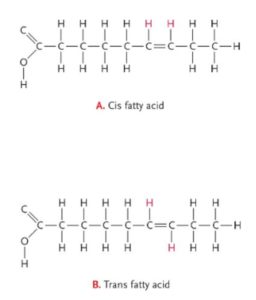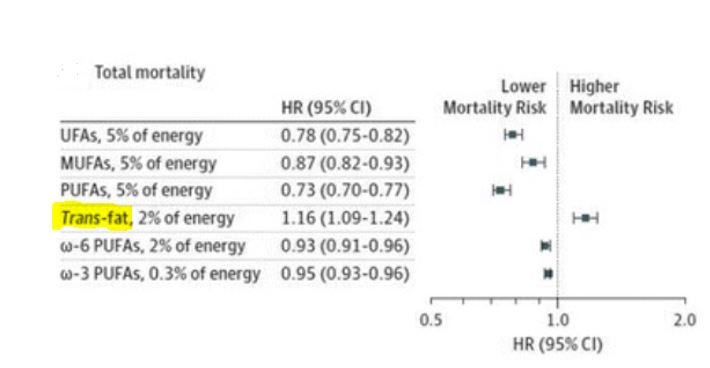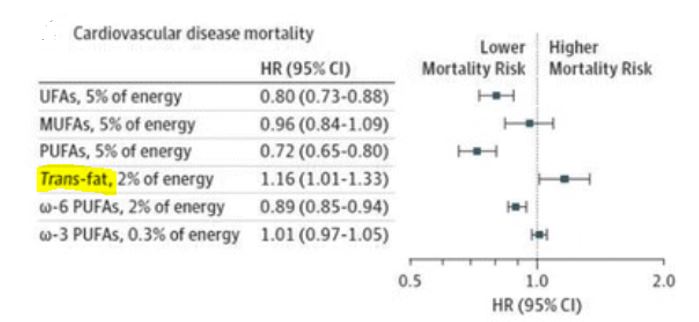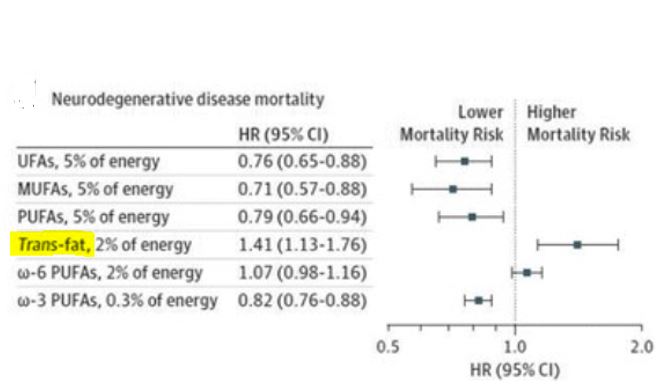Most of the fats in our diet are beneficial. We need to have fat to make cell membranes, produce certain hormones, transport dietary fats in the bloodstream, produce bile, make energy, absorb fat-soluble vitamins, produce lung surfactant, and produce myelin on nerve cells. But there is one type of fat that has no beneficial effects at all and is detrimental to our health because it is highly linked with chronic diseases like heart disease, cancer, and diabetes….and that is trans fat.
Look at the diagram below to see what the molecular structure of a trans fat looks like in comparison to a healthy unsaturated fatty acid like that found in olive oil. Notice how there is the tiniest of differences in location of hydrogen along the carbon chain beside the double bonds. That is all it takes to change a healthy cis fat into an inflammatory, disease-promoting trans fat. Unsaturated fats contain one or more double bonds and saturated fats do not contain any double bonds (they are saturated with hydrogen atoms). A monounsaturated fatty acid (MUFA) contains one double bond and a polyunsaturated fatty acid (PUFA) contains more than one double bond. I also want to point out that the three essential fatty acids that we have to consume in our diet, omega 3, 6, and 9, are all polyunsaturated fats. Trans fats can be formed around any double bond.

Unsaturated and saturated fat chemical structure
Unsaturated fats are oils, they are liquid at room temperature because the double bonds make the molecules bend, so they can’t get very close to each other like saturated fats, which are solid at room temperature. All fats are a mixture of different types of fatty acids though, so something like avocado oil is a liquid but contains a higher proportion of saturated fatty acids compared to olive oil. Coconut oil is mostly saturated fat and is generally solid at room temperature. Saturated fatty acids do not contain any double bonds and this makes them more stable for cooking.

Where do trans fats come from?
Back in the early 1900s a process called hydrogenation or partial-hydrogenation was used to add hydrogen to polyunsaturated fats to convert them into semi-solids, like margarine or vegetable shortening. The problem is that partial-hydrogenation forms trans fatty acids. Food companies love this process though because not only can you easily spread it on toast but it has an incredible shelf life, it gives all kinds of processed foods a great smooth texture, and it is super cheap.
Here are figures from a 2017 paper that correlated trans fat consumption and other fats in our diet with overall risk of death (mortality), cardiovascular disease, and neurodegenerative disease. You can see that trans fat consumption has a significant impact on our health.



Trans fats cause many health problems
- Increase risk of heart disease by increasing blood LDLs (“bad” blood cholesterol), lower HDLs (“good” blood cholesterol)
- Increase inflammation
- Promote endothelial cell dysfunction (blood vessels and internal linings are made from endothelial cells)
- Promote fatty liver disease
- Some studies show a correlation with increases in breast and colon cancer
- Increased risk of developing type 2 diabetes
- Increased abdominal fat and obesity
- Associated with increased asthma, allergies, and eczema
At least processed foods have to be labeled now so we can make sure foods don’t contain trans fat, right?
There is a little loop hole in the food industry. A label can say there is zero trans fat if there is less than 0.5 g per serving….so they can just make sure the serving size is set so that there is less than 0.5 g.
What foods contain trans fat?
If ‘partially hydrogenated, or hydrogenated’ vegetable oil is in the list of ingredients then there are trans fats. Also, generally any kind of processed packaged food that has a long shelf life and contains fat, foods such as margarines, vegetable shortening, pastries, cookies, cakes, pies, crackers, frozen pizza, fast food, basically anything packaged that is made with dough or batter, and anything deep fried (fast food) is going to have some amount of trans fats.
Trans fats are now banned ….however, the caveat still remains that a product is considered trans fat free if it contains less than 0.5 g per serving
The Food and Drug Administration has ruled that trans fats are no longer Generally Recognized As Safe (GRAS) and should be removed from the food supply. Denmark was the first country to ban trans fats in 2003 and finally in 2018, Canada and the US (along with many other countries) have also banned trans fats with a 3 year phasing out period; any products already on the shelves are allowed to be sold until 2021.
Because trans fats are banned does not mean that processed foods will start to contain healthy fats. They are simply working on modifying the hydrogenation process, altering temperatures and pressure used, fully hydrogenating oils rather than partially hydrogenating them. Fully hydrogenating vegetable oils would be basically producing saturated fats. So why don’t they just use saturated fat? There are 2 reasons:
- Creating fully hydrogenated saturated fats from refined oils is cheaper
- Fully hydrogenated saturated fats have a longer shelf life….if they don’t go bad then I would say that they are not the same as naturally occurring saturated fat. If bacteria and fungus won’t eat it then humans probably shouldn’t either.
The industry is also working on other methods including interesterification, which is a process affects melting point and crystallization so it can have desirable physical properties. So far, it seems that blood cholesterol levels are not affected by this process but studies are very limited at this point. Other methods include using fractions of oils that contain saturated fats like palm oil, palm kernel oil, or cottonseed oil but this has already been happening for a while and those fats are not necessarily unhealthy. But if you are going to buy margarine made with refined oils that contain saturated fats, why not just use butter? Grass-fed butter has amazing health benefits.
You can 100% eliminate industrial trans fats from your diet by making your own treats using butter, nut butters, nut oils, or coconut oil, or lard. Saturated fats are the best to use for cooking because they don’t have double bonds making them more stable. Lard would be the best choice if you want to deep fry something at home. Make sure it is not refined lard, read the package; if you find it on a shelf, then it will be refined. Good rendered lard would be refrigerated. I have only had success finding good lard at some butchers and markets, you likely won’t find it at a typical grocery store.
References
A healthy approach to dietary fats: understanding the science
Final determination regarding partially hydrogenated oils – Food and Drug Administration
Canada’s artificial trans fats ban comes into effect
Trans fatty Acids in Nutrition Labeling
Trans fats—sources, health risks and alternative approach – A review
Dairy Fats and Cardiovascular Disease: Do We Really Need to Be Concerned?

